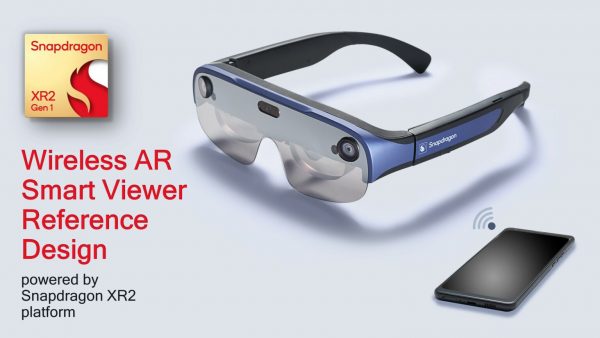Qualcomm Presents the First Wireless AR Glasses Reference Design
Qualcomm has cut the cord so to speak. The chipmaker has showcased a new reference design for XR2-powered Augmented Reality glasses that handles a wireless connection to a nearby PC, smartphone, or processing unit.
Qualcomm calls it “Wireless AR Smart Viewer” and the reference design has a diagonal field of view of approximately 40 degrees. The design prototype was built by Goertek, the same manufacturer used by the other bigwigs like Sony, Meta, and Pico for their VR HMDs.
We’re cutting the cord with our new wireless AR Smart Viewer Reference design. ✂️🔌 With the #Snapdragon XR2 Platform and @Qualcomm FastConnect 6900, it requires ZERO wires to deliver premium, immersive #XR experiences that unlock the #Metaverse. pic.twitter.com/sr5Z0CDXCf
— Snapdragon (@Snapdragon) May 20, 2022
The new reference design is just the latest in a series of HMDs that have been released from Qualcomm so far and it serves as a reference that Qualcomm’s partners can use to easily manufacture similar products using its chipset.
Last year, Qualcomm announced a wired AR Smart Viewer design that ran on its older and cheaper XR1 platform. The XR2 chipset is much bigger but also more expensive and is used in the Quest 2 headset, the Pico Neo 3 Link, and Vive Focus 3. In 2020, Qualcomm unveiled a reference design for a virtual reality headset that was based on the XR2 chip.
According to Qualcomm, several manufacturers are already having a look at the new wireless design. The design divides the rendering and processing tasks between a compatible wireless device and the glasses. Qualcomm says that the latency between a smartphone and the glasses is less than 3 milliseconds. The Wireless AR Smart Viewer also has a 90Hz refresh rate along with a resolution of 1920 x 1080 per eye in a micro-OLED display.

Currently, very few companies are leveraging Qualcomm’s reference design to develop new AR and VR markets. The consumer market is almost completely dominated by the aggressively-priced Meta Quest 2. On the other hand, slim AR glass designs have such a small field of view that they are unlikely to appeal to the wider consumer market. Lenovo’s ThinkReality A3 smart glasses were built alongside the XR1-based reference design and are currently only targeting the enterprise market.
https://virtualrealitytimes.com/2022/05/20/qualcomm-presents-the-first-wireless-ar-glasses-reference-design/https://virtualrealitytimes.com/wp-content/uploads/2022/05/Wireless-AR-Smart-Viewer-Design-600x338.jpghttps://virtualrealitytimes.com/wp-content/uploads/2022/05/Wireless-AR-Smart-Viewer-Design-150x90.jpgAR HeadsetsHardwareTechnologyQualcomm has cut the cord so to speak. The chipmaker has showcased a new reference design for XR2-powered Augmented Reality glasses that handles a wireless connection to a nearby PC, smartphone, or processing unit. Qualcomm calls it “Wireless AR Smart Viewer” and the reference design has a diagonal field of...Kristin HummelKristin Hummel[email protected]AuthorVirtual Reality Times - Metaverse & VR
